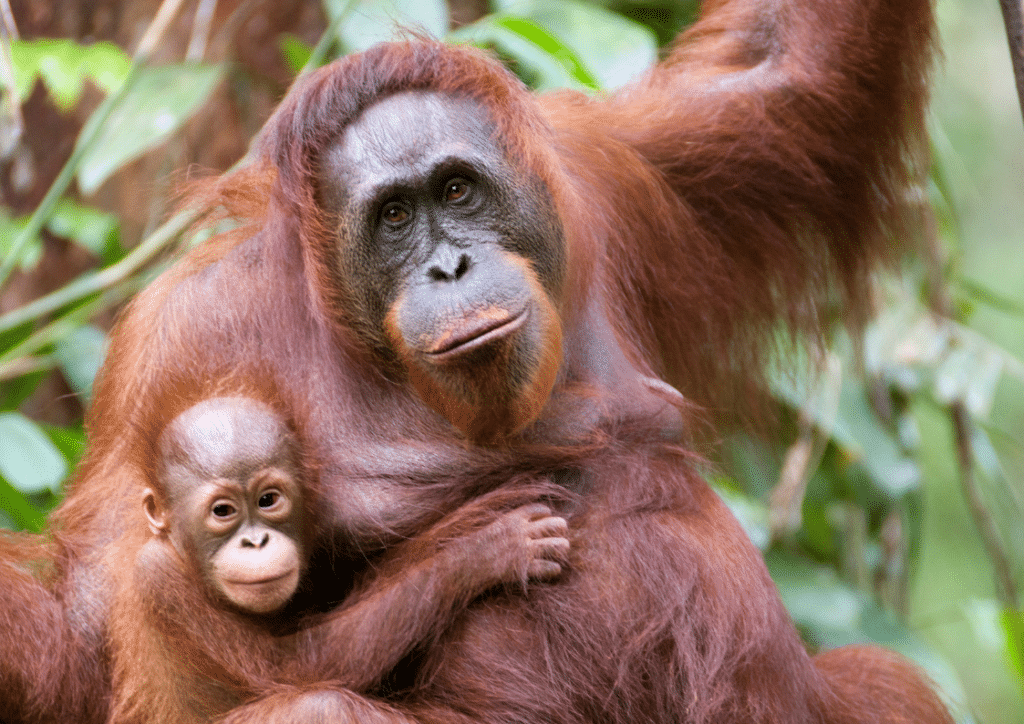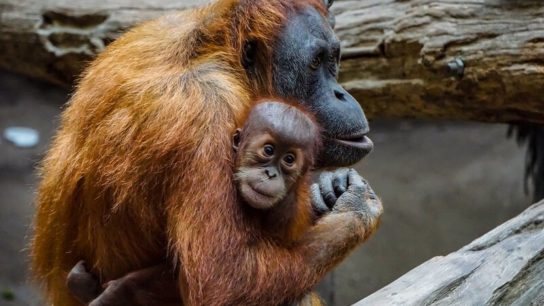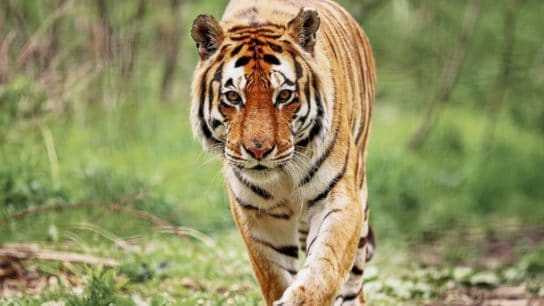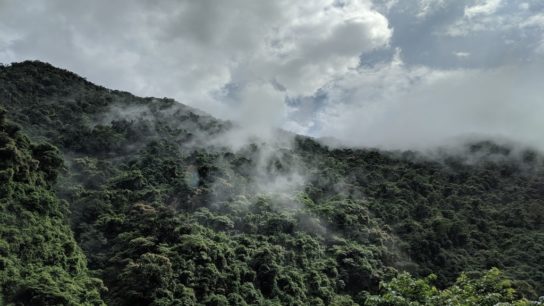Every year on August 19, the world celebrates International Orangutan Day. There’s no better time to celebrate all things related to the tree-dwelling animal. Here are some fun facts about orangutans you might not know about.
—
11 Fun Facts About Orangutans
1. There are three species of orangutans
Bornean, Sumatran and Tapanuli are all species of orangutans. Easily identifiable by their reddish, ginger-tinted fur, the three orangutans species have many similarities including the presence of beards and moustaches in adult males – and for some adult females. However, Bornean orangutans tend to have darker and redder coats and rounder faces.
2. Orangutans can live up to 60 years
Most orangutans in the wild live up to 30-40 years but some have been recorded to reach the age of 50 years or, in some rare cases, more. The animal also significantly differs in sizes between males and females. Male orangutans can often weigh more than 90 kilograms (198 pounds), whereas females are a third or half their sizes.
3. Orangutans are the largest tree-dwelling mammals
Orangutans are large apes that share nearly 97% of the same DNA as humans, making them one of our closest relatives. The word “orang-hutan” literally translates into English as “person of the forest.” They also spend 80% of their time in the tree, from climbing, travelling and building sleeping nests in trees.
4. Orangutans have signature long arms
Orangutans have an average height of about 1.5 meters (4.9 feet). One of the most interesting facts about orangutans is that they have disproportionately long arms that can span up to 2.2 meters (7.2 feet). Their arms tend to be one and a half times longer than their legs, and can be stretched to their ankles when standing. The orangutan uses its long arms to form a secure hook that allows them to travel from tree to tree. Despite spending most of their time in trees, orangutans are semi-terrestrial and walk on all fours when travelling on the ground.

5. Some male orangutans develop large cheek pads on their faces
Not all, but some male orangutans develop large cheek pads, also known as flanges, on the side of their faces. They’re essentially fatty tissues which are developed when the males are fully matured, at around 35 years old. Apparently, many female orangutans find these flanges to be attractive and take them into consideration when they’re choosing a mate. Males also have a throat sac, which they use to vocalise, locate and advertise their presence to females or warn other males away.
You might also like: The Project Working to Provide a Lifeline For Trafficked Orangutans
6. Orangutans are astonishingly intelligent animals
Extensive research and laboratory tests in the last few decades have revealed that orangutans are a highly intelligent species for their ability to use a variety of sophisticated tools and build elaborate sleeping nests from branches and foliage. Orangutans have been named the world’s most intelligent animals in a study that places them even above chimpanzees and gorillas.
7. Orangutans have incredibly close bonds with their mothers
While most mammals tend to stay close to their mothers during the early stages of their lives, orangutans stick to their mothers for much longer, most at least until the age of seven. Young orangutans will ride on their mothers’s body when they’re travelling and sleep in their nests. During this period, they will absorb all the knowledge Mum has to share including food hunting and how to use tools.
8. Orangutans have opposable thumbs and toes
Much like us humans, the great ape’s opposable thumbs and big toes come in handy when they’re hunting for food, and have often been known to make use of tools such as sticks and branches to reach termites and ants out of small spaces. Orangutans eat more than 300 different kinds of fruits, and they’ve learned to use leaves to form a protective glove when handling pricklier fruits.
9. Orangutans are critically endangered
All three species of orangutans are currently considered to be “critically endangered” by the International Union for the Conservation of Nature (IUCN). There are fewer than 70,000 Bornean, 14,000 Sumatran and 800 Tapanuli orangutans left in the wild. As they’re only found in swamp forests of Borneo and Sumatra, the species is incredibly vulnerable due to increasing harmful human activities.
You might also like: 12 Incredible Facts About Elephants
10. Deforestation is the largest threat to orangutans
Commercial agriculture such as palm oil, urbanisation, infrastructure and increased land uses have been the biggest drivers of deforestation in the last few decades. Borneo alone is projected to lose about 220,000 km sq of forest between 2010 and 2030, approximately 30% of its total land area. However, the countries of Indonesia and Malaysia have made significant efforts to limit deforestation, and rates of its forest loss have been slowing down. That being, as the effects of climate change worsens, risks of wildfires increases, which poses significant impacts to orangutan habitats.
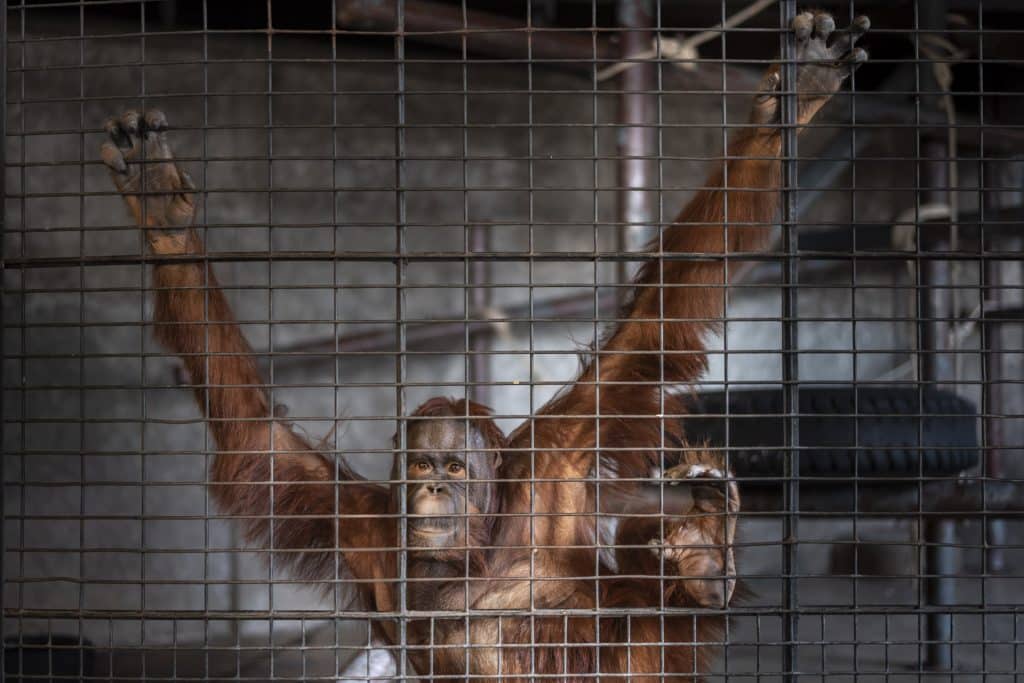
11. Orangutans are victims of wildlife trade and tourism
Orangutans have been victims of illegal wildlife trading across the world and a significant amount of the population have been exploited for entertainment as part of wildlife tourism. For example, in Thailand, orangutans have been forced to perform in mock boxing matches, as documented by award-winning photographer Aaron Gekoski, as well as take part in circus-style shows for tourists.
This article was first published on August 19, 2022.
How can I contribute to a more sustainable planet?
- 🗳️ Vote for Climate Action: Exercise your democratic rights by supporting candidates and policies that prioritize climate change mitigation and environmental protection. Stay informed with Earth.Org’s election coverage.
- 👣 Reduce Your Carbon Footprint: Make conscious choices to reduce your carbon footprint. Opt for renewable energy sources, conserve energy at home, use public transportation or carpool, and embrace sustainable practices like recycling and composting.
- 💰 Support Environmental Organizations: Join forces with organizations like Earth.Org and its NGO partners, dedicated to educating the public on environmental issues and solutions, supporting conservation efforts, holding those responsible accountable, and advocating for effective environmental solutions. Your support can amplify their efforts and drive positive change.
- 🌱 Embrace Sustainable Habits: Make sustainable choices in your everyday life. Reduce single-use plastics, choose eco-friendly products, prioritize a plant-based diet and reduce meat consumption, and opt for sustainable fashion and transportation. Small changes can have a big impact.
- 💬 Be Vocal, Engage and Educate Others: Spread awareness about the climate crisis and the importance of environmental stewardship. Engage in conversations, share information, and inspire others to take action. Together, we can create a global movement for a sustainable future.
- 🪧 Stand with Climate Activists: Show your support for activists on the frontlines of climate action. Attend peaceful protests, rallies, and marches, or join online campaigns to raise awareness and demand policy changes. By amplifying their voices, you contribute to building a stronger movement for climate justice and a sustainable future.
For more actionable steps, visit our ‘What Can I do?‘ page.
This story is funded by readers like you
Our non-profit newsroom provides climate coverage free of charge and advertising. Your one-off or monthly donations play a crucial role in supporting our operations, expanding our reach, and maintaining our editorial independence.
About EO | Mission Statement | Impact & Reach | Write for us




